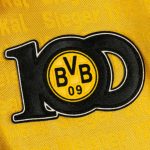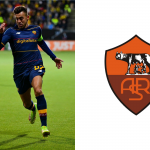
Lions on football teams' crest
A thousand-year-old tradition
March 1st, 2023
The badges of football teams show monuments, flags, symbols and animals. And in the latter case, several clubs throughout their history have chosen an animal symbol with imposing and fierce features. This is the lion, the regal and majestic king of the savannah, which appears in the logos of many football clubs around the world, most notably in Italy and England.
The Lagoon Lion of Venezia and the Ciociaro Lion of Frosinone
The lion on the crest of Venice is also the symbol of the lagoon city of the ancient Republic of Serenissima, the so-called winged lion or Lion of St Mark in reference to its patron saint. The winged feline has always featured in the coat of arms of the orange and green club. In the latest logo, signed by Bureau Borsche, the face of the animal appears as one within the large 'V'.
The lion in Frosinone's crest also refers to the symbol of the city of Ciociaria. Since 1963, despite various changes in shape and structure, the feline predator has been firmly anchored in the association's logo. Since 2007, the Gialloblù club has also had a mascot representing the King of the Savannah, named Lillo, which was chosen by the fans in an internet poll.
Brescia and Siracusa
The rampant lion, also a symbol of the city, was at the heart of Brescia's Scudetto for many years before a modernist turn came in 2017 with the unveiling of the new logo. Under the lettering 'BSFC', an acronym for Brescia Football Club, appears the stylised, roaring head of the feline predator. a modern and forward-looking graphic style maintains a solid link to its origins and identity, which it represents with honour and pride," explains the Lombard club.
The lion, on the other hand, was not always the symbol of Siracuse, which wore a rooster at the beginning of its history, probably in reference to the historic hometown poet, Tommaso Gallo, who was featured in the team's crest. In the 1940s, the lion appeared on the jerseys of the Sicilian team, where it can still be seen with a proud temperament.
The rampant lion of Chelsea
The most famous savannah king among Premier League clubs is surely that of Chelsea. The crest with the rampant lion was adopted by the Blues in 1953, in honour of the crest of the Earls of Cadogan, who owned the London club at the time. In 1986, the lion changed from "rampant" to "roaring" before Roman Abramovich reintroduced the old logo in 2005, the year of the club's centenary.
The roars of Millwall and Reading
In England, it's not just Chelsea that wears the royal cat on its chest. Among the most famous clubs is Millwall, one of the hottest and 'most dangerous' supporters' clubs in Europe, whose stadium - 'The Dan' - is even nicknamed 'The Lions' Den'. And the club's crest alone, an aggressive lion in an attacking position, makes it clear how fearsome it is to face the Dockers.
The lion on Reading's crest, on the other hand, is based on the May Wall Lion, a sculpture and memorial to the 329 fallen of the 66th (Berkshire) Infantry Regiment, which saw action in the Second Anglo-Afghan War between 1878 and 1880. The cat can be seen in the upper right corner of the badge of the Royals.
The Copenhagen Lion
Two lions are found in the crest of the city of Copenhagen and so the animal with the thick mane is also found on the badge of the Danish team, the most successful in the nation. In the club's round logo, the cat takes up almost the entire space. And it is precisely because of the lion's presence that Copenhagen fans and players are nicknamed 'Løverne', meaning lion.
The French 'Lyon
Olympique Lyon is probably the team par excellence that represents the lion, and how could it be otherwise, given the club's name. The French incorporated the feline predator into their coat of arms in 1996, after it had been the symbol of the city for centuries. The animal was also present outside the main entrance of the Gerland, Lyon's old stadium before its move to the Parc Olympique Lyonnais, with no fewer than two lion sculptures.
The Lion of Sporting Lisbon
Sporting Lisbon players are known as Leos because of their relationship with this animal. It is not surprising, then, that both the team and the Portuguese capital are historically linked to the symbol of the rampant lion. This detail comes from the heraldic crest of Count Don Fernando de Castelo Branco, with the lion being introduced in 1920. Despite the various redesigns of Sporting's coat of arms, the feline predator has always been firmly at the centre of the club's logo.
Lions all over the world
One team that has been very Italian in the past, with Marco Rossi on the bench and Davide Lanzafame as bomber, has a golden rampant lion in the centre of its crest: that is Budapest Honved, winner of no less than 14 Hungarian championships. Gothenburg, Sweden, also has a lion with a crown and a sword in one paw in its white and gold coat of arms. The cat has been on the city's coat of arms since it was placed on the Swedish throne in 1364 by the then House of Folkung.
In Scotland it is Rangers Glasgow who display on their badge a red rampant lion with a tongue of fire clearly visible. Originally, the Scottish club's crest was a monogram of the letters RFC (Rangers Football Club), but in 1959 the club decided to adopt the animal, which is reminiscent of both the Scottish Football Association logo and the old royal crest and national flag known as the Lion Rampant.
When Orlando City left the borders of Europe and flew to the United States, the club associated its nickname (Lions) with a large golden lion's head on its badge. Originally, the American club's crest even featured three roaring lion heads, but now the number has been reduced to one.

















































